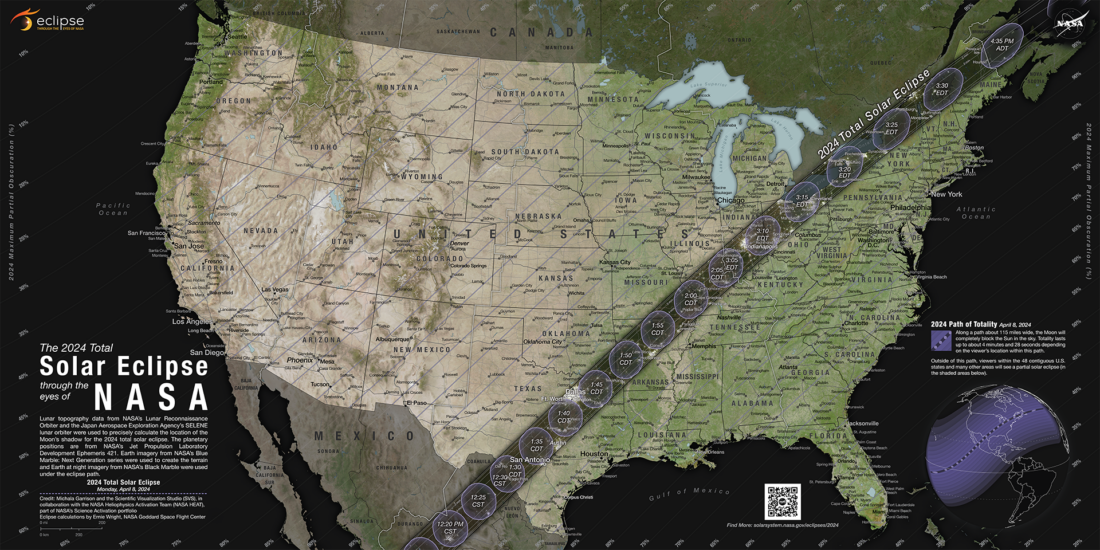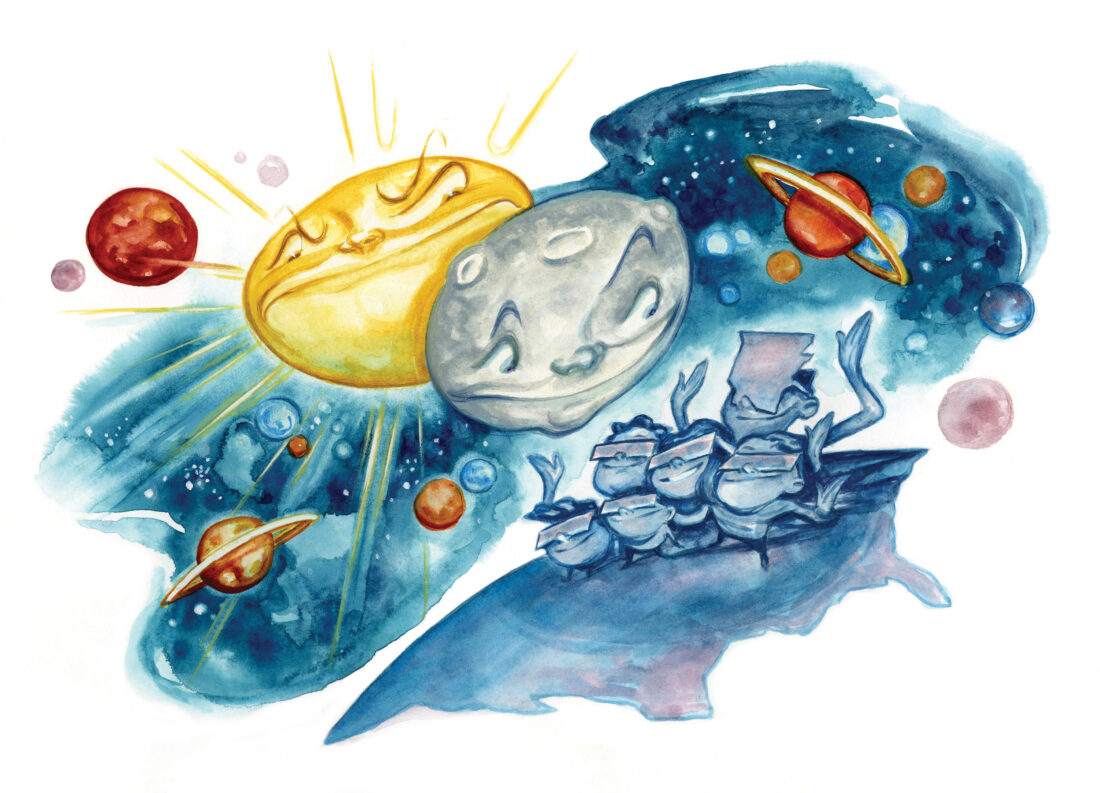The time draws nigh, or at least nigh-ish, for a rare total eclipse to traverse the United States, including portions of the South. The April 8 event will darken our skies, fire our imaginations, and—given it’s occurring smack on a Monday afternoon—provide a stellar excuse for a long lunch break.

Starting shortly past noon in southern Texas, when the moon’s orbit begins to pass between the Earth and the sun, and for the next several hours, the entire South will experience the eclipse to some degree. (More on that later.) But only within a much narrower swath, about 115 miles wide, will the moon be seen to cover the sun’s entire surface. In the U.S., that “path of totality” (which sounds both cool and a bit ominous) arcs northeast from Texas to Maine, touching Oklahoma, Arkansas, Missouri, Kentucky, and a teeny sliver of Tennessee along the way.
How much does being in the path of totality enhance the occurrence? Dramatically, according to Dr. John Mulchaey, observatories director for the Carnegie Institution for Science and an admitted eclipse junkie who will gather with about thirty astronomer pals at the Perot Museum of Nature and Science in Dallas, a prime viewing locale. “To get the true experience, you do need totality,” he says. “For most of the event, even [in the path of totality], it will be similar to a partial eclipse; the sun slowly will be obscured by a portion of the moon, which most people have seen. Then, very quickly, some spectacular things happen.”
He elaborates: “Fifteen minutes before totality comes a gray, gloomy period—it’s pretty eerie. In the last few seconds, just a bit of sun still gleams in the corner, which we call the ‘diamond ring effect.’ Then the surface is entirely covered, and the only remaining light is diffused light from the sun’s corona extending beyond the moon’s perimeter. It’s not pitch black, but it’s similar to the end of twilight, dark enough to see stars and planets. It’s almost unreal.”
Underscoring the peculiarity of the moment, a total eclipse’s effects aren’t confined to the heavens. “Animals are caught completely off-guard, and some get nervous. Daytime birds stop singing, and the creatures you normally hear at night, like insects and night birds, perk up,” Mulchaey says, adding that we chatty humans are often awestruck and silent, too. “You kind of understand why eclipses were huge deals for ancient cultures. Wars have started and ended because of eclipses. Astronomers have been beheaded for failing to predict them.”
This particular eclipse is notable for delivering a long duration of totality, exceeding four minutes along the centerline of the path. (By comparison, the August 2017 total eclipse that bisected the Southeast maxed out at two minutes and forty seconds.) Timing also plays a part, as the blotting of a high-in-the-sky afternoon sun is more vivid than one near dawn or dusk. Of course, this assumes the weather cooperates. Eclipse chasers are advised to check the forecast three days in advance and adjust final destinations as needed if cloud cover is predicted.

Thinking you’re too totally busy for a total eclipse and will just catch the next one? Totally think again. The next total eclipse to cross the South isn’t expected until August 12, 2045. The continental U.S. runner-up? Montana and North Dakota in 2044. If that information shifts you into planning gear, here are some options, direct from the path of totality, for those who want to witness the eclipse with a crowd and those who might prefer contemplative seclusion.
Texas
Dallas is the largest city in the path of totality; its Perot Museum of Nature and Science, partnered with the Carnegie Institution for Science, is inviting eclipse watchers to its grounds and the adjacent Klyde Warren Park for an event that includes a live DJ, food trucks, games, and hands-on STEM activities. Not to be outdone, it seems every brewery and winery in Austin (that’s a lot) is beckoning those who want to pair the sun’s brownout with an adult beverage.
Oklahoma
After crossing the Red River at 1:44 p.m., totality covers thirty-one miles in the southeastern corner of the Sooner State. Townships Broken Bow and Idabel sit squarely in that path, as do Beavers Bend and Hochatown state parks.
Arkansas
No, Bonnie Tyler isn’t performing at the Total Eclipse of the Heart Festival in Russellville, but there will be plenty of blues and country music, plus barbecue, hot-air balloons, and axe throwing. (Perhaps those last two shouldn’t be combined, but never mind.) If you consider the occasion appropriate for going a bit New Agey, head instead for Mount Ida, a small mountain town near Ouchita National Forest that proclaims itself the “quartz crystal capital of the world.” Or to witness how a global assortment of animals reacts to the eclipse, be at the Little Rock Zoo (advance ticket required).
Missouri
In rural southern Missouri, Fourche Creek Conservation Area straddles the centerline and will enjoy the longest totality in the state. On the other hand, Cape Girardeau knows a bit about this stuff, having also been in the path of the 2017 eclipse, and is planning a big watch party at the Cape Girardeau SportsPlex with viewing stands, kid’s activities, and food trucks.
Tennessee
If you insist on keeping your feet in the Volunteer State while experiencing totality, head toward the northwest corner, then follow Route 22 north of Tiptonville into a small, anvil-shaped nub of Lake County that pokes up next to Missouri and Kentucky. Totality won’t last long there, but you can say you did it!
Kentucky
Kentucky squeezes just enough of its squiggly western borderlands into the path of totality to warrant two suggestions. Paducah is inviting locals and visitors alike to its charming downtown and riverfront for the X Marks the Spot Festival. A little farther northeast in Henderson, Ellis Park is opening its historic thoroughbred racetrack to eclipse viewers, so bring your chairs and blankets.
Otherwise…
What if you’re stuck at home, unable to travel to the relatively slim path of totality? As noted by Mulchaey, you won’t get the “true experience” of a total eclipse, but that doesn’t mean that a partial eclipse isn’t worth your attention. For instance, in Memphis, sixty miles from the nearest edge of totality, 97 percent of the sun will be covered. In Atlanta, it’s 82 percent, and as far away as Charleston, 70 percent. So get your eclipse glasses, already!








